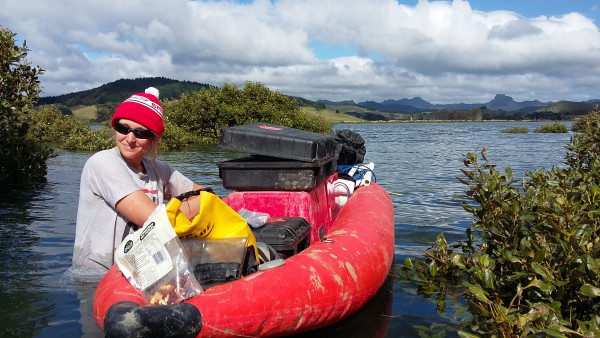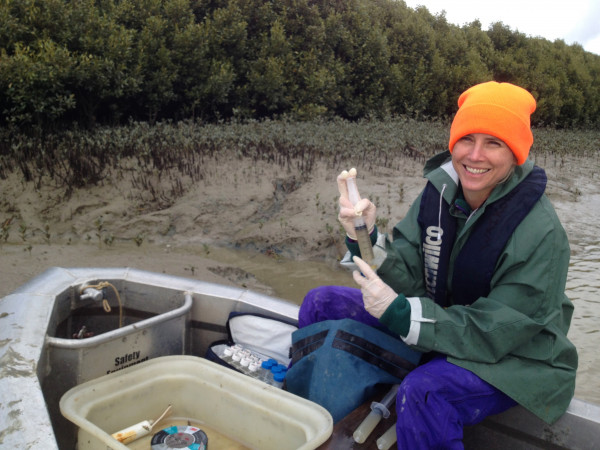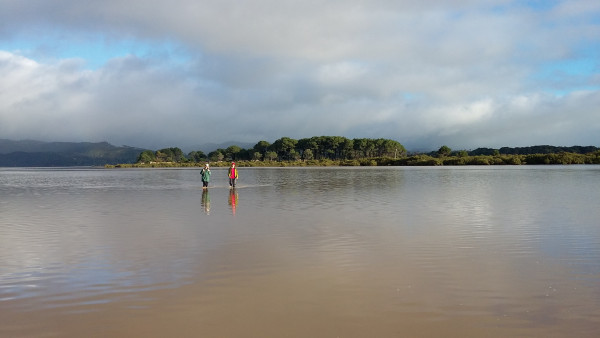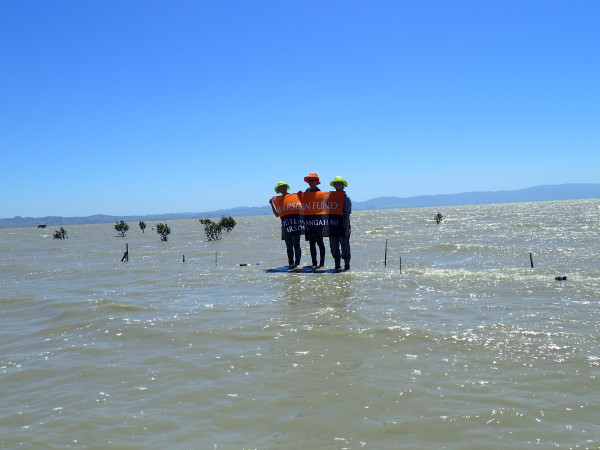Mud, Mangroves, and the Marsden Flag
Erik Horstman, Rebekah Haughey and Dean Sandwell surveying the vegetation in the Firth of Thames mangrove forest
Posted: Mon, 30 Jan 2017
Accompanied by Associate Professor Karin Bryan and Dr Julia Mullarney, the Marsden Fund Flag ventured deep into the mangrove swamps of the Hauraki Gulf.
Mangrove swamps are one of the world's most effective carbon-burial ecosystems, yet they are declining worldwide.
In collaboration with Associate Professor Stephen Henderson from Washington State University and Postdoctoral Fellow Erik Horstman, Karin and Julia are studying the effects that Mangroves have on the flow of the surrounding seawater and sediment in an attempt to better understand the cause of their demise.
Mangrove trees spread seaward by establishing seedlings and roots, which in turn alters the hydrodynamics of the surrounding water. Depending on their density, these structures can enhance or reduce sediment supply to the swamp, with implications for the swamps survival. To date, the complexity of the flow in these environments has confounded the ability of numerical models to accurately estimate the flow of seawater and thus the sediment budget.
Focusing on sediment movement at the mangrove canopy-fringe boundary, this project (Marsden Fund contract UOW1402) ultimately aims to determine how subtle variations at this boundary control the mangroves ability to establish and grow.
Below is a photo gallery of the research team deploying current profilers, sediment traps, and other scientific equipment in the field.

Julia Mullarney running the vectrino current meters (logging into computers in the black case) which are measuring turbulence in the fringe of the mangrove forest in Whangapoua Harbour, Coromandel.
Erik Horstman, Rebekah Haughey and Dean Sandwell surveying the vegetation in the Firth of Thames mangrove forest while trying to avoid being mistaken for ducks during hunting season!Erik Horstman, Rebekah Haughey and Dean Sandwell setting up the surveying base station in the Firth of Thames mangrove forest.
Erik Horstman, Rebekah Haughey and Dean Sandwell surveying the vegetation in the Firth of Thames mangrove forest while trying to avoid being mistaken for ducks during hunting season!Erik Horstman, Rebekah Haughey and Dean Sandwell setting up the surveying base station in the Firth of Thames mangrove forest.

Karin Bryan sampling surface water draining off the mangrove forest in the Firth of Thames. (Photo credit: Ben Stewart)
The base station at low tide with all the gear ready to ship out at Whangapoua Harbour, Coromandel.
Instrument loggers working full capacity at high tide at the sampling base station in Whangapoua Harbour, Coromandel.
Hauling the equipment out to the transect location in Whangapoua Harbour, Coromandel.

Erik Horstman set up for overnight sampling at Whangapoua Harbour, Coromandel.

Julia Mullarney and Karin Bryan taking the overnight watch of the sampling transect at Whangapoua Harbour, Coromandel.
Julia Mullarney with the newly-constructed access frame at the Firth of Thames. The steel arm cantilevers out over the mangrove roots so that the seabed will not get disturbed by footprints.

Holding the Marsden flag high and dry as a king tide floods the boardwalk in the Firth of Thames
